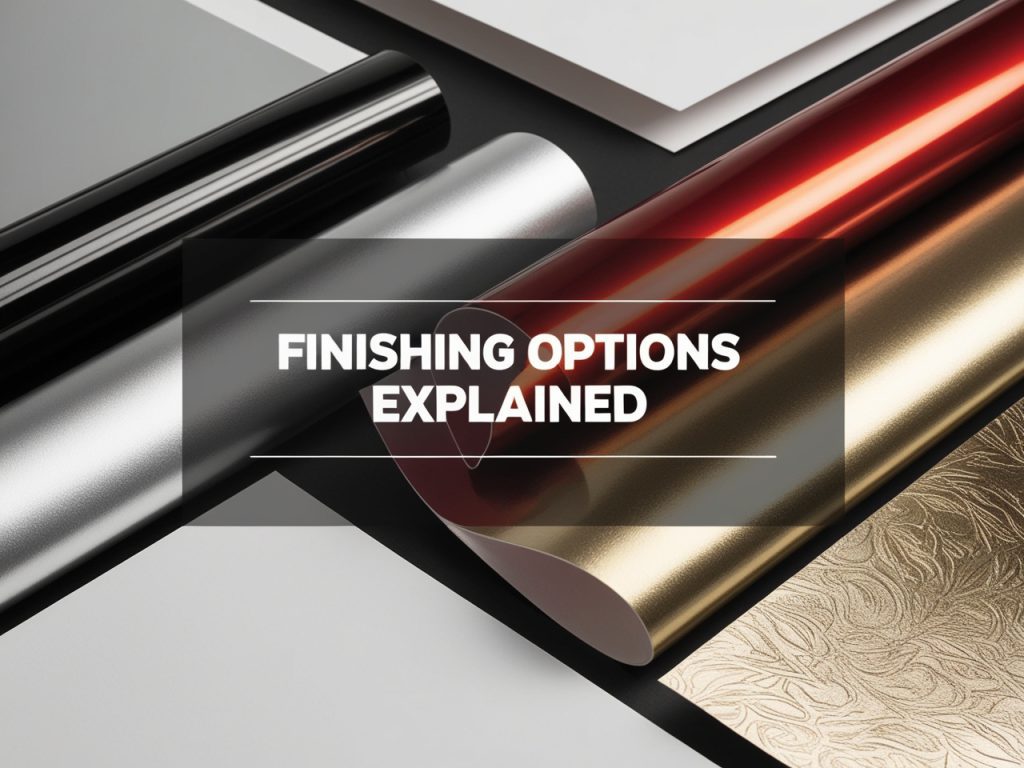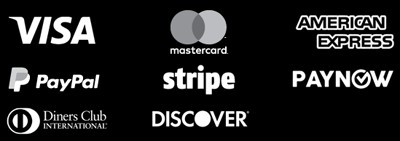
Finishing options can elevate your printed materials by adding a professional, tactile, and visually appealing touch. From protective coatings to decorative enhancements, print finishes not only improve the durability of your products but also enhance their appearance and feel. This guide will walk you through the most common finishing options like lamination, spot UV, foil stamping, and more, helping you decide which finish best suits your project.
1. Lamination #
Lamination involves applying a thin plastic film to both sides of your printed material, creating a smooth, protective layer. Lamination enhances durability and provides a premium feel. There are two main types of lamination: gloss and matte.
Best For: #
- Business Cards
- Brochures
- Menus
- Book Covers
- Packaging
Gloss Lamination: #
- Appearance: Creates a shiny, reflective finish that enhances color vibrancy and gives your prints a sleek, polished look.
- Benefits:
- Vibrant Colors: The gloss finish makes colors pop, giving your designs a more eye-catching appearance.
- Protection: Laminated prints are more resistant to dirt, moisture, and wear, making them durable and long-lasting.
- Drawbacks:
- Glare: The glossy surface may create glare under certain lighting conditions, making it harder to read text.
Matte Lamination: #
- Appearance: Provides a smooth, non-reflective finish that gives your prints a soft, elegant feel.
- Benefits:
- Professional Look: Matte lamination is often considered more sophisticated and professional, making it ideal for business cards and premium marketing materials.
- Non-Reflective: No glare, ensuring readability even in bright light.
- Drawbacks:
- Less Vibrant Colors: Colors may appear slightly muted compared to gloss lamination.
2. Spot UV Coating #
Spot UV (ultraviolet) coating is a finishing technique that adds a glossy, raised effect to specific areas of your print, such as logos, text, or design elements. It contrasts with a matte background, creating a visually striking and tactile experience.
Best For: #
- Business Cards
- Invitations
- Brochures
- Product Packaging
Benefits: #
- High Contrast: Spot UV creates a dramatic contrast between the matte and glossy areas, making key elements stand out.
- Tactile Appeal: The raised, glossy texture adds a premium feel to the printed material.
- Durability: Spot UV coating protects the coated areas from wear and tear.
Drawbacks: #
- Limited Application: Spot UV works best on thick paper stocks and is not ideal for intricate designs with small details.
- Cost: Spot UV can be more expensive than standard finishes due to the additional process involved.
Pro Tip: Spot UV is especially effective when used selectively on logos or key text, creating a visual and tactile highlight that grabs attention.
3. Foil Stamping #
Foil stamping is a finishing technique that applies a metallic foil (usually gold, silver, or copper) to certain areas of your printed material. It adds a luxurious and eye-catching touch to logos, borders, or important text.
Best For: #
- Invitations
- Business Cards
- Certificates
- Greeting Cards
- Packaging
Benefits: #
- Luxurious Appearance: Foil stamping adds a high-end, elegant look to your print materials, making them stand out.
- Reflective Finish: The metallic foil reflects light, giving the print a shiny, eye-catching finish.
- Customizable: Foils are available in various colors, including gold, silver, rose gold, and even holographic options.
Drawbacks: #
- Higher Cost: Foil stamping is a premium finishing option, often more expensive than other finishes.
- Best for Simple Designs: Foil stamping works best with simple, bold designs. Small details may not transfer well onto the foil.
Pro Tip: Use foil stamping for logos, titles, or accents to add a touch of luxury and sophistication to your printed materials.
4. Embossing and Debossing #
Embossing and debossing are finishing techniques that create raised or recessed impressions on the surface of the paper, giving your printed materials a tactile, 3D effect.
- Embossing: Raises the design above the paper’s surface.
- Debossing: Presses the design into the paper, creating a sunken effect.
Best For: #
- Business Cards
- Invitations
- Packaging
- Certificates
Benefits: #
- Tactile Element: Embossing and debossing add texture to your design, creating a sophisticated, professional look.
- No Ink Required: These techniques are purely structural, so they can be used without ink or color, or combined with ink or foil stamping for added impact.
Drawbacks: #
- Limited Color Impact: Embossing and debossing are typically used for creating texture rather than adding color, so they may need to be combined with other finishes for visual effect.
- Higher Cost: These processes can add to the overall cost due to the custom dies required.
Pro Tip: Embossing and debossing are great for adding elegance and texture to logos, titles, or decorative elements on invitations, cards, and business stationery.
5. Die-Cutting #
Die-cutting is the process of cutting paper into custom shapes or designs, creating unique and distinctive printed materials. A metal die is used to cut specific shapes from the paper, allowing you to create interesting outlines or cutouts.
Best For: #
- Business Cards
- Packaging
- Invitations
- Custom Shaped Promotional Materials
Benefits: #
- Customizable Shapes: Die-cutting allows for endless creativity by enabling custom shapes beyond the standard rectangle or square. You can create unique business cards, invitations, or brochures that stand out.
- Versatile: This finishing option can be applied to many types of paper and materials, allowing for creative freedom in design.
Drawbacks: #
- Higher Cost: Custom dies are required for die-cutting, making it a more expensive finishing option.
- Complexity: Intricate designs may be harder to achieve with die-cutting, depending on the material and design.
Pro Tip: Use die-cutting for creative projects like custom-shaped business cards, windowed packaging, or interactive invitations to make your print materials truly stand out.
6. Varnish #
Varnish is a clear coating applied to printed materials to protect the paper and enhance the appearance of the print. It comes in various finishes, including gloss, matte, and satin, and is often used to highlight specific areas of a design or to add an extra layer of durability.
Best For: #
- Brochures
- Flyers
- Posters
- Packaging
Benefits: #
- Added Protection: Varnish adds a protective layer to your printed materials, making them more resistant to scuffs, fingerprints, and general wear and tear.
- Customizable Finishes: Varnish is available in gloss, matte, and satin finishes, allowing you to choose the level of shine and texture that fits your project.
- Spot Varnish Option: Like spot UV, spot varnish can be applied to specific areas of your design to create a contrast between matte and glossy finishes.
Drawbacks: #
- Subtle Effect: While varnish adds protection, it may not have the same visual or tactile impact as other finishing options like foil stamping or embossing.
Pro Tip: Varnish is a cost-effective way to protect your prints while subtly enhancing their visual appeal. Use spot varnish for a more targeted, striking effect.
7. Soft Touch Coating #
Soft Touch Coating is a finishing option that provides a smooth, velvety feel to your printed materials. It adds a subtle, matte finish that feels luxurious to the touch, making it a popular choice for high-end products.
Best For: #
- Business Cards
- Packaging
- Luxury Brochures
- Invitations
Benefits: #
- Tactile Appeal: Soft touch coating adds a velvety, soft feel that enhances the sensory experience of your printed materials.
- Premium Look: The matte, muted finish conveys elegance and sophistication, making it ideal for luxury brands and products.
- Durable: Soft touch coating offers some protection against scratches and scuffs, extending the life of your print.
Drawbacks: #
- Higher Cost: Soft touch coating is typically more expensive than standard gloss or matte finishes.
- Muted Colors: The matte finish can slightly dull bright colors, so it may not be ideal for designs that require high color vibrancy.
Pro Tip: Soft touch coating is perfect for business cards, luxury brochures, and packaging where tactile experience matters. It conveys quality and refinement without being overly flashy.
Conclusion #
Choosing the right finishing option can significantly enhance the quality, appearance, and feel of your printed materials. Whether you want a luxurious metallic look with foil stamping, a sleek and protective gloss lamination, or a tactile effect with embossing, the finishing touches are what make your project stand out. By carefully selecting finishes that align with your design goals, you can create print materials that leave a lasting impression on your audience.





